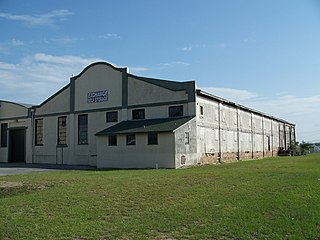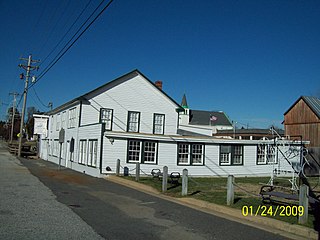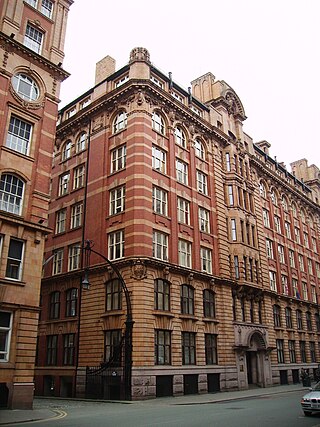
Tarpon Springs is a city in Pinellas County, Florida, United States. The population was 23,484 at the 2010 census. Downtown Tarpon Springs has long been a focal point and is undergoing beautification.
Old Post Office, or Former Post Office, may refer to:

The Strawn Historic Citrus Packing House District is a U.S. historic district located at 5707 Lake Winona Road in DeLeon Springs, Florida in Volusia County. It contains 12 historic buildings and 3 structures. The packing house is in a state of abandoned decay and has not been operation since 1983.

The E. R. Meres Sponge Packing House is a historic site in Tarpon Springs, Florida. It is located at 106 West Park Street. On April 10, 1991, it was added to the U.S. National Register of Historic Places.

The N. G. Arfaras Sponge Packing House is a historic site in Tarpon Springs, Florida. It is located at 26 West Park Street. On April 10, 1991, it was added to the U.S. National Register of Historic Places.

The Auburndale Citrus Growers Association Packing House is a historic site in Auburndale, Florida. It is located at 214 Orange Street. On July 17, 1997, it was added to the U.S. National Register of Historic Places.
This is an incomplete list of historic properties and districts at United States colleges and universities that are listed on the National Register of Historic Places (NRHP). This includes National Historic Landmarks (NHLs) and other National Register of Historic Places listings. It includes listings at current and former educational institutions.

J. C. Lore Oyster House, also known as J. C. Lore and Sons, Inc., Seafood Packing Plant, is located at 14430 Solomons Island Road South, in Solomons, Calvert County, Maryland. It is a large two story, rectangular frame industrial building constructed in 1934 as a seafood packing plant. It replaced a 1922 building that was destroyed by the 1933 Chesapeake Potomac hurricane. It is significant for its historical association with the commercial fisheries of Maryland's Patuxent River region, and architecturally as a substantially unaltered example of an early-20th century seafood packing plant. It has been adapted by the Calvert Marine Museum to house exhibits and many of its original spaces, artifacts, and records have been incorporated into them.

Bridgewater House is a packing and shipping warehouse at 58–60 Whitworth Street, Manchester, England. It is recorded in the National Heritage List for England as a designated Grade II listed building.

The Elephant Packing House was built in 1924, in Fullerton, Orange County, Southern California. Valencia oranges were packed here, from the abundant orchards that then dominated the county. William Wolfskill had developed and extensively planted the Valencia orange here in the 19th century. It is one of the last remaining examples of a citrus packing house in Fullerton.
Whaley House may refer to:

The Bivalve Oyster Packing Houses and Docks are located along Shell Road in the Bivalve section of Commercial Township in Cumberland County, New Jersey. They were added to the National Register of Historic Places on February 28, 1996, for their significance in commerce and maritime history during the years 1870–1945. The listing includes five contributing buildings. The buildings were listed as part of the Marine and Architectural Resources of the Maurice River Cove Multiple Property Documentation Form (MPDF). The Bayshore Center, an educational museum, is located adjacent to the property at 2800 High Street.

Asia House at No. 82 Princess Street, Manchester, England, is an early 20th century packing and shipping warehouse built between 1906 and 1909 in an Edwardian Baroque style. It is a Grade II* listed building as at 3 October 1974. Nikolaus Pevsner's The Buildings of England describes the warehouse, and its companion, No. 86, Manchester House, as "quite splendid ... good examples of the warehouse type designed for multiple occupation by shipping merchants". It attributes its design to I.R.E. Birkett, architect of the Grade II listed companion building, Manchester House, which is similar in design. English Heritage attributes it to Harry S. Fairhurst. Asia House has an "exceptionally rich" entrance hall and stairwell, "lined with veined marble and green and cream faience, with designs of trees and Art Nouveau stained glass".

Lancaster House in Whitworth Street, Manchester, England, is a former packing and shipping warehouse built between 1905 and 1910 for Lloyd's Packing Warehouses Limited, which had, by merger, become the dominant commercial packing company in early 20th century Manchester. It is in the favoured Edwardian Baroque style and constructed with a steel frame clad with granite at the base and Accrington red brick and orange terracotta. The back of the building is plain red brick. It is a Grade II* listed building as of 3 October 1974.

India House in Whitworth Street, Manchester, England, is a packing and shipping warehouse built in 1906 for Lloyd's Packing Warehouses Limited, which had, by merger, become the dominant commercial packing company in early-20th century Manchester. It is in the favoured Edwardian Baroque style and is steel-framed, with cladding of buff terracotta and red brick with buff terracotta dressings. It is a Grade II* listed building as of 3 October 1974.
In the final half of the 19th century Manchester's reputation as a financial and commercial centre was boosted by the unprecedented number of warehouses erected in the city centre. In 1806 there were just over 1,000 but by 1815 this had almost doubled to 1,819. Manchester was dubbed "warehouse city". The earliest were built around King Street although by 1850 warehouses had spread to Portland Street and later to Whitworth Street. They are direct descendants of the canal warehouses of Castlefield.

The Mission Citrus Growers Union Packing Shed in Mission, Texas, also known as Edinburg Citrus Association and as Growers Select Produce Packing Shed, is a historic packing house. It was built in 1944. It was listed on the National Register of Historic Places in 2002.

The Anaheim Packing House is a 42,000-square-foot (3,900 m2) gourmet food hall in Downtown Anaheim, California, United States. Along with the Packard Building, a renovated 1925 Mission Revival style building, and a farmer's market, it makes up a shopping center called the Anaheim Packing District. The Packing House opened on May 31, 2014, and is located in a renovated 1919 former Sunkist citrus packing house built in Spanish Colonial Revival style. It is one of the few remaining packing houses in Orange County, and the only one in Anaheim. The packing house was added to the National Register of Historic Places as the Anaheim Orange and Lemon Association Packing House in 2015.















